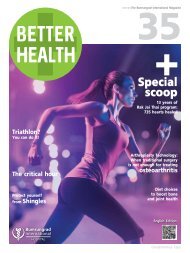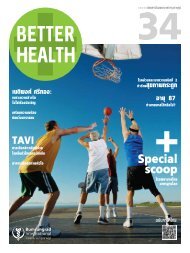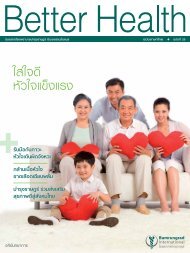Better Health 34 ENG
The magazine for patients and friends of Bumrungrad International Hospital, Thailand.
The magazine for patients and friends of Bumrungrad International Hospital, Thailand.
Create successful ePaper yourself
Turn your PDF publications into a flip-book with our unique Google optimized e-Paper software.
How long does marathon preparation take?<br />
If your physician finds no problems that restrict running a marathon,<br />
Dr. Montinee recommends conducting a self-assessment to determine what<br />
category of runner you are. Typically, the levels are categorized as Beginner,<br />
Intermediate, Advanced, and Competitive.<br />
Run regularly<br />
3 to 5 Days/Week<br />
Total Running<br />
Distance/Week<br />
(Km./Week)<br />
Approximate<br />
Period for Marathon<br />
Preparation<br />
Beginner P 25 1 year<br />
Intermediate P 32 6 months<br />
Advanced P 64 4 months<br />
Competitive P Over 80 4 months<br />
Not even a beginner?<br />
For a beginner, set a reasonable first<br />
target, and then, subsequently set goals<br />
to achieve gradual progress. If you never<br />
exercise on a regular basis, you should<br />
start with walking or running with<br />
breaks for about 30 minutes daily,<br />
three to five times a week. After sticking<br />
to this program for a while, you can<br />
proceed to short-distance running,<br />
such as a Fun Run, which requires two<br />
to three months of preparation. The<br />
goal is to gradually increase your<br />
running time and distance.<br />
“At least one week before the race,<br />
a participant should do a practice run.”<br />
says Dr. Montinee. This rehearsal<br />
instills confidence and prepares the<br />
athlete for competition. Unprepared<br />
runners increase the risk of injuries<br />
and medical problems. As much as<br />
possible, athletes should train under<br />
conditions similar to what they will<br />
encounter in the actua l race, such as<br />
humidity, distance, and route, to<br />
achieve a physical adaptation.<br />
For those who seek running a<br />
marathon, they should consult their<br />
physician or trainer to get advice<br />
about exercising, eating, and hydration<br />
and sweat rate (the amount of sweat<br />
lost in a one-hour exercise session),<br />
and specific techniques for safety<br />
and running efficiency.<br />
Follow these instructions and<br />
recommendations:<br />
+ Choose well-organized running<br />
events. Screen potential races for<br />
systematic planning regarding<br />
accurate distance, route conditions,<br />
facilities, and safety. For example,<br />
the event should provide first-aid<br />
services with medical personnel and<br />
medical equipment (such as an automated<br />
electrical defibrillator (AED)).<br />
+ Do not run outdoors during hot<br />
daytime temperatures of over 35<br />
degrees Celsius, particularly with<br />
high relative humidity.<br />
+ Use only your “broken-in” running<br />
shoes that fit the foot’s shape and<br />
sole, adequately absorb impact force,<br />
and suit the course and road surface.<br />
Don’t wear brand-new or untested<br />
shoes in a race.<br />
+ Refrain from alcohol at least 24 hours<br />
before the race.<br />
+ Do body warm-ups and stretches<br />
before every run.<br />
+ Have a meal one to two hours before<br />
the race. In the case of a marathon<br />
session of over two hours, doctors<br />
recommend consuming food or<br />
drinks with about one gram of<br />
carbohydrate/kilogram every hour;<br />
you may have liquid foods (e.g. gelatins)<br />
or an energy bar to energize your<br />
body during the race.<br />
+ Drink enough water to prevent<br />
dehydration. But be careful! Drinking<br />
too much water may cause mineral<br />
levels to drop to dangerously low<br />
levels, leading to brain swelling.<br />
Drink only enough water to quench<br />
your thirst. Alternate between water<br />
and sports drinks at 120 to 180<br />
milliliters every 15 to 20 minutes.<br />
+ Long, continuous endurance exercises<br />
cause changes in the cardiac muscle,<br />
which poses a possible risk of heart<br />
disease. Even an experienced runner<br />
should have regular health check-ups.<br />
Walking or running: it’s all good<br />
For those not yet ready or who have<br />
health problems that preclude running,<br />
a study published in the Journal of the<br />
American College of Cardiology (JACC)<br />
in 2014 found that exercise of even just<br />
10 minutes per day is beneficial to health<br />
and helps prolong life in comparison<br />
to those who do not exercise at all.<br />
“Even walking is advantageous<br />
because the key to good exercise is to<br />
do it continuously and regularly,” says<br />
Dr. Montinee. “For example, a brisk walk<br />
or jog for just 30 minutes per day, three<br />
days per week benefits health more<br />
than a hard run once a month. You don’t<br />
need to overdo exercise. Just make<br />
sure it’s suitable for your current<br />
physical condition.”<br />
What’s so good about running?<br />
Apart from being a convenient<br />
and inexpensive exercise,<br />
running also has other<br />
advantages:<br />
+ Helps increase muscular strength<br />
in several parts of the body – from<br />
legs and arms muscles to the<br />
cardiac muscle<br />
+ As a weight-bearing exercise, it<br />
helps strengthen bones<br />
+ Decreases blood pressure and<br />
blood lipids and regulates sugar<br />
levels.<br />
+ Reduces the risk of cardiovascular<br />
and cerebrovascular diseases<br />
+ Facilitates good metabolism and<br />
controls weight<br />
16
















